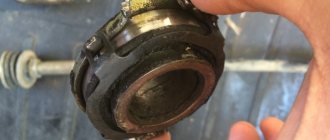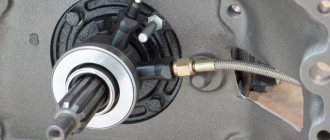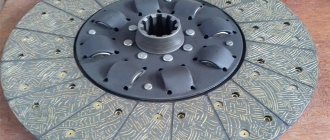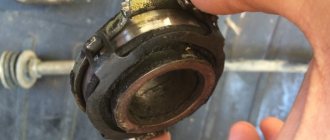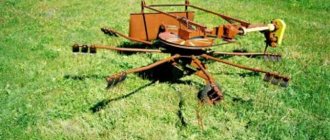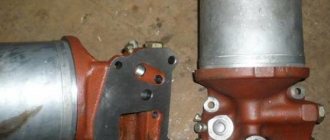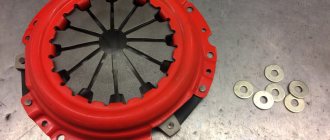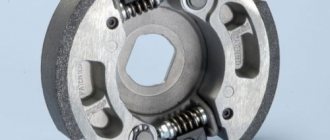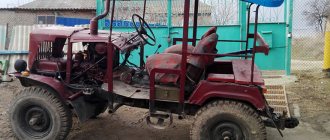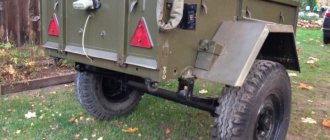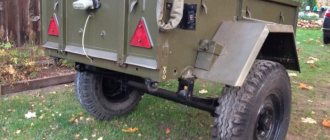A clutch is one of the components of a car’s transmission, which serves to temporarily disconnect the gearbox from the engine, as well as smoothly engage it. It is a basket in which the main parts are assembled - the driven and pressure plate, fork, release bearing and leaf spring. With proper operation, you only need to change the driven disk and lubricate some elements. Their list also includes a release bearing. It needs lubrication periodically, and this can be determined by the noise when you press the clutch pedal.
How does a release bearing work?
The release bearing is mounted on the input shaft of the gearbox and has splines on the inside that prevent it from turning. The essence of the work is this: the driver uses the pedal to create pressure in the main cylinder, which transmits it to the working piston. A rod is attached to it, and a fork is attached to the rod. It rests on special places in the release bearing (antennae), thereby pushing it along the input shaft to the leaf spring. Having rested against it, it begins to work, that is, to spin. Simply put, the device is active only when the clutch pedal is depressed, when it comes into contact with the spring.
Release bearing operation
When does a mechanism need to be replaced?
Let's consider when there is a need to replace this mechanism. Replacement and repair of the MTZ-82 clutch is carried out in the following cases:
- The device does not allow you to obtain full torque.
- The pedal moves partially or the radius of its movement increases several times.
- The driven disc linings, lift brackets or cuffs are worn.
- Doesn't turn off completely.
- Oil gets onto a dry disc.
- The drive shaft bearing cap has been squeezed out.
The MTZ-80 clutch basket is repaired and adjusted in the same way. This wheeled tractor model, like the 1221 and 320, has the same reasons for clutch wear.
Do I need to lubricate the release bearing?
If the car is operated in unfavorable conditions, that is, through sand, mud, water, etc., then there is a risk that the release bearing will begin to make noise. Water is especially dangerous, as it easily gets into all the gaps and holes. The bearing itself is closed, but there is nothing sealed around it, so all the moisture and dust gets there. Then the question arises, is it possible to somehow restore it?
In principle this is possible, but not in all cases. If it gets too worn out you will have to throw it away. Well, the essence of restoration is to clean it and re-lubricate it. In general, such things are not intended for repair. Simply put, all sealed bearings are filled with lubricant at the factory, which is just enough for the duration of operation. If you are going to update it, then think about whether it is worth it. But in any case it is possible.
Appearance of the release bearing
How to lubricate a release bearing without removing the box
Based on the above material, we learned that the release bearing is mounted on the input shaft of the gearbox. This means that when replacing it you will have to remove it too. And then the question immediately arises: “Is it possible to lubricate the release lever without dismantling the boxes?”
Release bearing in gearbox
Unfortunately, it is impossible to do this when it is installed on the car. Moreover, you won’t even be able to get close to it, since the so-called clutch cover or bell will get in the way. Therefore, in order to lubricate the release lever, you must first remove the box and not invent a bicycle. Then the question arises again. Why lubricate it at all if you have to disassemble half the transmission to do it? It’s easier to just buy a new one, install it and not fool yourself. This is basically what most drivers do, moreover, it is highly recommended to do so! But, if you need this fundamentally or for some other reason, you can remove the old release lever and lubricate it.
Signs and causes of release bearing failure
The clutch, or rather the clutch release bearing, breaks due to the fact that it experiences uneven loads while the clutch is depressed and the bearing moves back along with the driven disk. Because of this, it is not recommended to keep the clutch pedal depressed.
If a knocking sound occurs when you press the clutch pedal, this indicates wear on the clutch bearing. As a rule, if there are problems with the bearing, you can still use it for some time.
What fan drive is on your car? Check out the working principle of a viscous fan coupling for an alternative.
Is it possible to lubricate the clutch disc splines without removing the gearbox?
Post by VV777 » Sat Apr 07, 2012 12:28
Post by Arkady62 » Sat Apr 07, 2012 17:21
Post by VV777 » Sat Apr 07, 2012 17:49
Post by esenin » Sat Apr 07, 2012 17:59
Post by VV777 » Sat Apr 07, 2012 19:51
Lubrication on the shaft splines is of great importance; without it, the softness of disengaging and engaging the clutch disappears, as if it were a jerk. The disc should move very easily along the splines, without jamming. My clutch is released well and the free play is still normal and has not changed since the new one.
Then I think I’ll just move the box, it takes a lot of time to remove. esenin, is it easy to prop the box on a stand? One person probably can't lift it under the car? How many hands do you need for such an operation? I don't have a hole. Please describe your physical difficulties?
Post by Grandfather Vova » Sat Apr 07, 2012 19:58
Post by hc2hunter » Sat Apr 07, 2012 20:58
VV777 Someone here had a cool experience
